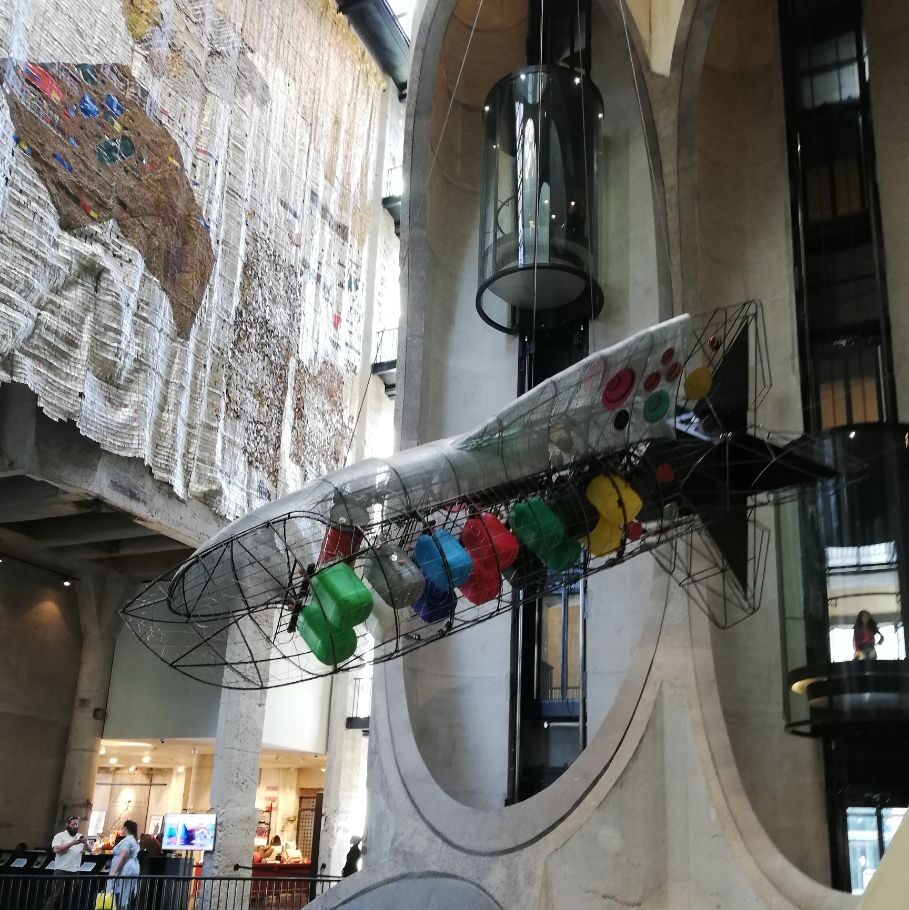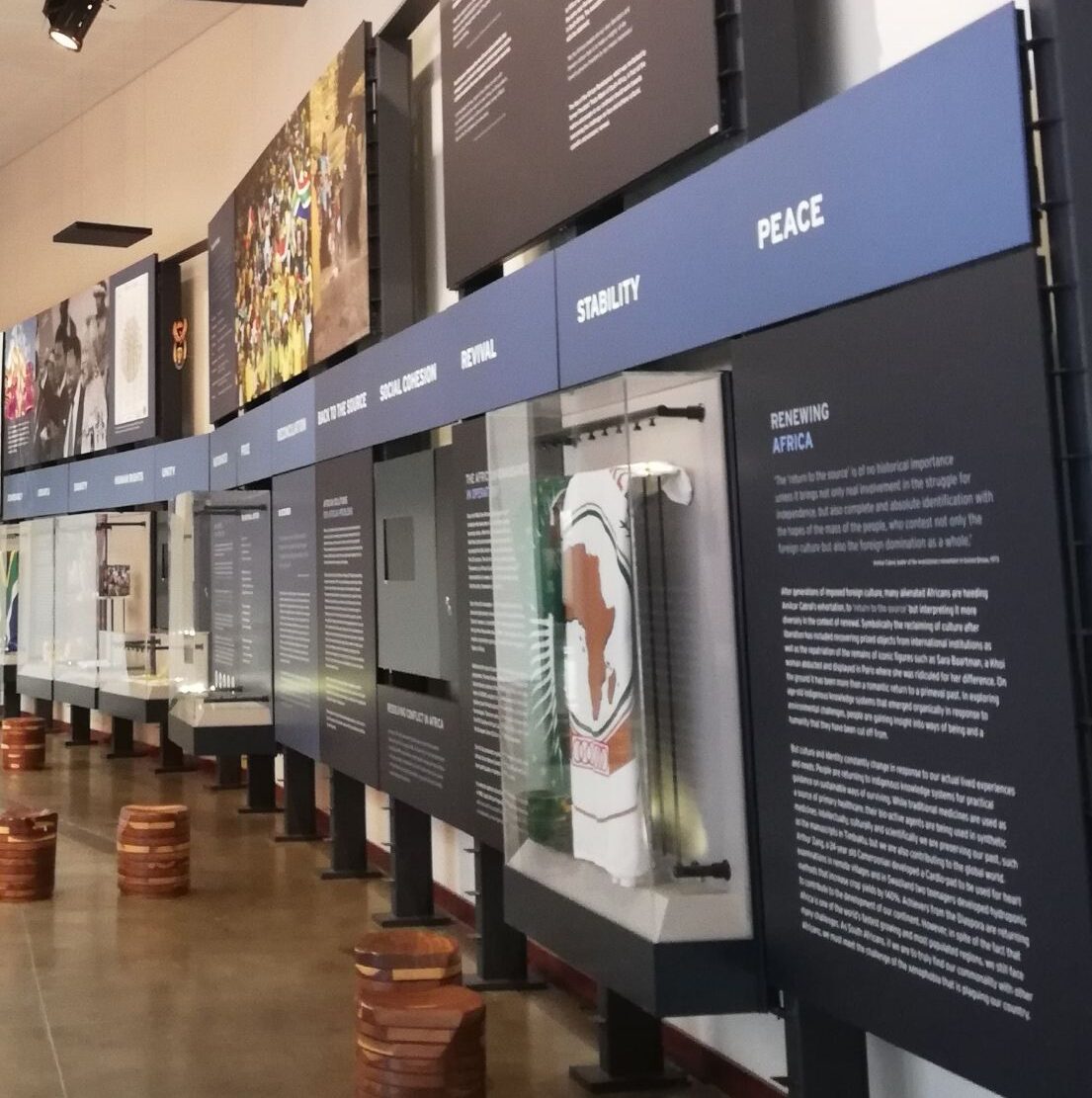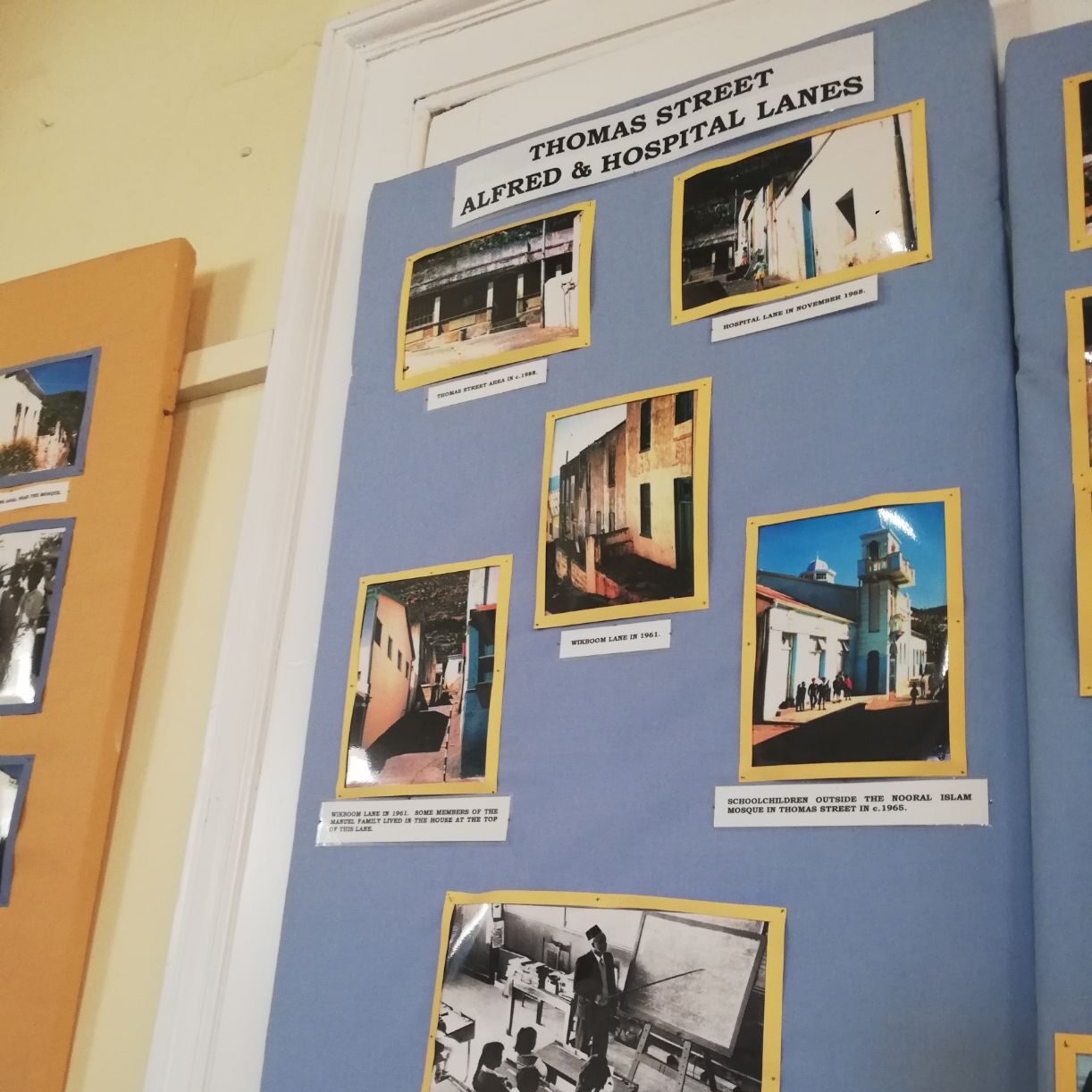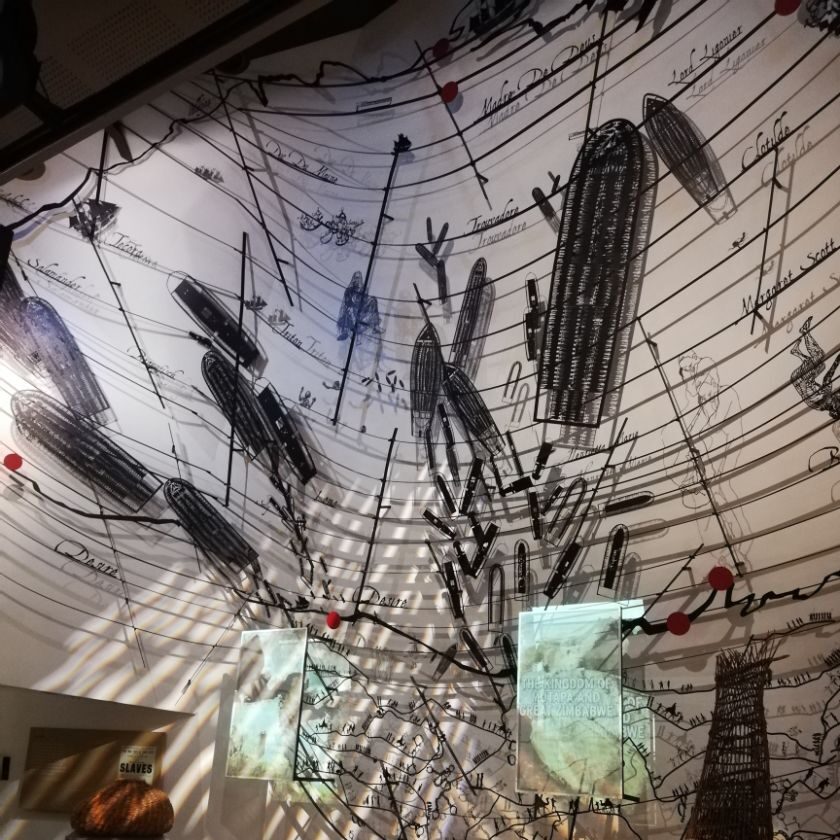Forging the Future Simon’s Town Museum in the Fire

Despite funding shortages and the isolation of social distancing, the Simon’s Town Museum’s community-building work is making a positive impact on the Cape Flats. Education officer Tazneem Wentzel talks about the future of institutions that trade in the past.
A hedged-in parking lot sits at the base of the former Governor’s Residency, now the Simon’s Town Museum. Above the wire fencing, the sea peeks out. A long grey military vessel floats off the harbour. The wide, worn stone staircase ascends onto the veranda of the startling-white 18th-century building. The porch is barricaded in by white wooden shutters. A door swings open, and Tazneem Wentzel, in a grey hoodie, headscarf and tracksuit pants, peers around and beckons me up the stairs.
Tazneem has come full-circle in her relationship with museums. When she was eight or nine years old, she took the train to Simon’s Town with her classmates and walked up to this very building. “As a child, I wanted to be an archaeologist. So, this was, you know, very cool to me,” she gushes later in our Zoom call.
The visit made an impression on her; today she is the education officer at the Simon’s Town Museum. In her words, the education officer creates and markets programmes and events for “people coming to the museum”. Part of this involves showing visitors around the museum, as she’s doing for me today.
The Simon’s Town Museum is a community museum that was established in 1977 by the local historical society. According to its website, the museum “collects and exhibits the cultural history of the people of Simon’s Town and their connections with the Dutch East India Company and the Royal Navy”. Community museums are multidisciplinary, displaying anything related to their subject community — art, history, folklore. As Tazneem takes me around the building, I spot porcelain teacups, ostrich eggs used by the Khoisan, stained film photographs of family events, military medals, British army-issued chocolate and fermented chillies in a reconstructed trammakassie, or pantry. But for the glass exhibition cases and solemn hush that lingers over the place, you might confuse it for an antique dealer or a bric-and-brac stall at a church fete.
Tazneem tells me that this is exactly the appeal of the museum. “It’s not like a MoMA, all sleek, and people like that. It’s a little bit, you know, flexible, old, it’s a little bit outdated. People enjoy that kind of uniqueness.”
The Simon’s Town Museum is certainly a far cry from the sophisticated architecture of art museums like New York’s Museum of Modern Art (MoMA) or Cape Town’s Zeitz Museum of Contemporary African Art. Once you’re past those chic window shutters, it’s an old, though large, granny’s house. There are memorabilia and bits and bobs galore. Your shoes echo on the wooden floors and there are unexplained creaks. I’m advised to avoid one room, where the floorboards tilt precariously under the skirting board.
This homely atmosphere, says Tazneem, is the future of museums. “The time for the big, grand museum is over,” she says a few days later over Zoom. “It’s time for the smaller periphery museums.”
When I ask her why, the reply is blunt. “Just because of the way funding works,” she says. She tells me of the museum’s efforts to raise money for basic operational costs like photocopying and electricity. These include partnerships she is arranging with local businesses. While the salaries of the five permanent staff members are paid by the government, they must fund the rest of their overheads. In a profoundly tumultuous period, in which cultural institutions like the Apartheid Museum and the Fugard Theatre have been forced to shut their doors (either temporarily or permanently), the concern around finances is valid and pressing. In pre-pandemic times, the museum generated income through admissions but during my time in the building, it was devoid of visitors. It’s closed to the general public, a combined result of lockdown and the need to redo the installations.
Before lockdown, the museum received school groups, international visitors and locals. Tazneem feels that nostalgia is a big part of the museum’s appeal for both international and local groups. Overseas visitors are drawn by the military history (the town was the winter base for the Dutch East India Company and the museum building itself was once home to the company’s governor). Meanwhile, locals come to reminisce about life before the forced removals of the 1960s. Is there not a tension between these visitors who come from opposite sides of South Africa’s racist history?
“I had a guy once, who was part of the secret police during Apartheid, so you can imagine the kind of thing that he was involved in,” Tazneem says by way of acknowledging this tension. “And I try to communicate that story to them so that they can make that connection themselves about what kind of impact they had on people. And, for example, this guy…I think he was very touched when he actually realised, you know, the kind of long-term impact they had on communities.”
Government policy and academic papers are always enthusiastic about museums’ role in nation-building and social cohesion post-Apartheid. It’s an argument that sounds just a bit too optimistic, too loaded with images of Rainbow Nation unity and TRC-style forgiveness, to be believable so it’s impressive to hear from Tazneem that these rather abstract concepts do actually play out in real situations.
However, while she appreciates the significance of this reconciliation in the broader post-Apartheid story, Tazneem’s priority seems to be closer to home: validating and supporting the victims of Apartheid and giving them space to talk about a history that was marginalised. “I focus a lot of my heritage education programs on rebuilding ties with the community,” she says of the community of around 7000 people who were forcibly removed from Simon’s Town in the1960s.
Tazneem can personally identify with this painful history, as the grandchild of Capetonians who suffered Apartheid-era removals. Reclaiming this identity played a big role in her childhood. “It was very important for my father that I went to school in the areas that he originally lived. When they tell you, ‘No, you can’t come to the school because you are not from the area,’ he was very adamant that we would have been from the area, if it wasn’t for the forced removals.”
As a child, Tazneem spent hours sorting through the family photo albums, intrigued by the passage of time in her family. She pursued history at university, graduating cum laude with an MA in history from the University of the Western Cape in 2019. The subject of her thesis was the Wembley Whopper and Super Fisheries Gatsby, celebrated meals on the Cape Flats which, according to her research, reflect both the racialised nature of food under Apartheid, and the resilience of these Black-owned eateries in that era.
The interplay of culture, activism and history is clearly something she’s passionate about. And it’s at this intersection, too, that you’ll find the beating heart of the Simon’s Town Museum. Tazneem uses her multidisciplinary skills to create “experiential” and “playful” heritage programmes. Her favourite initiative was a collaboration for International Day of Families with the District Six Museum and the Cape Town Museum of Childhood a couple of years back. “We got elderly people and young interns together from all these sites of forced removals —from Simon’s Town, from Diep River and from District Six — and everybody had to describe the games that they used to play when they were younger,” she recalls fondly. “It was quite a joke.”
One of Tazneem’s current projects is the Albert Thomas Oral History Project, which she is running in close partnership with the District Six Museum and the Phoenix Project, a committee established in 1996 by Simonites, who had been removed during Apartheid, in order to preserve their community’s heritage. The initiative was set up in March 2020 in order to encourage former residents to record their recollections of life before the removals. It was originally conceived of as a series of structured interviews but transformed during lockdown into a WhatsApp group and a set of Facebook prompts.
Lockdown and the need for social distancing have had unexpected blessings, Tazneem reveals. “What was nice about it was that a lot of people hadn’t heard from friends in a long time but on the group a lot of them reconnected.”
Intergenerational relationships were also nurtured. The project makes use of seven youth ambassadors who create prompts for participants to respond to and former Simonites roped in their children and grandchildren to transmit their memories to the museum.
“A lot of the grandchildren don’t know about the forced removals because the grandparents haven’t spoken to them about it!” Tazneem explains. She feels strongly that this intergenerational conversation helps to address the socio-economic problems on the Cape Flats today. “Because, for example, Ocean View was a direct construction as a result of Apartheid because that was where the Coloured people were supposed to go. So, the problems that Ocean View has today are directly linked to Apartheid and to forced removals.”
Shining a spotlight on this underrepresented history, as the museum does in its ‘People of Simon’s Town Room’ is a transformation post-1994 from the military history of Simon’s Town — and the colonial and Apartheid associations which that bears. But this commitment to transformation goes beyond putting together a reconstruction of multiracial Simon’s Town for outsiders to devour.
“Collecting data and putting it on display is one aspect of a museum. That’s really basic,” Tazneem asserts. “A museum is much more than that. A museum should be a space where all these kinds of heritages and histories can clash with one another and redefine one another.”
Clashing. Redefining. This is crucial for the future of museums; they must, Tazneem elucidates, be “fluid and organic and responsive to the context.” Such an example is perhaps her favourite museum: the Burning Museum, the arts collective of which she was a part. Disenchanted with the exclusion of Black people from gallery spaces and the violent history of the colonial museum archive, the group tried to reimagine the representation of Black bodies by creating public art installations. “We put up these archival images, other kinds of representations of ourselves that we would want to see in the public spaces, that is not your gangster, your stereotypes; these are just ordinary families, you know.”
It seems improbable that a museum education officer would be involved with a group named Burning Museum but I suspect that, as with the Phoenix Project, the name is more about reclaiming the power of structural, sometimes violent, change for the marginalised.
The fires of Apartheid and the coronavirus pandemic continue to wreak profound violence across the museum landscape in South Africa. But, as Tazneem and the success of the oral history project have indicated, there is the potential for something quite extraordinary to emerge from the sweltering flames. If they can keep up their fundraising and community-building efforts, it looks like the Simon’s Town Museum, as it lives in Tazneem and former Simonites, could be just such an extraordinary upshot.









